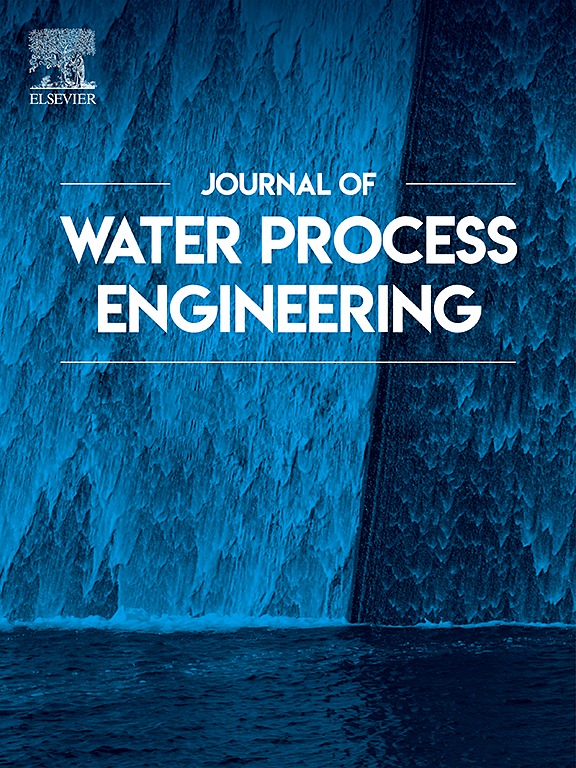厌氧消化出水两级汽提法处理氨回收及防垢
IF 6.3
2区 工程技术
Q1 ENGINEERING, CHEMICAL
引用次数: 0
摘要
在食物垃圾的厌氧消化中,氨抑制和结垢的形成是稳定运行的挑战。本文以实际厌氧消化出水为例,开发了一种两级溶出技术来解决这一问题。首先在55℃、1.5 L/min条件下进行气提,去除氨,提高pH,促进废水中Ca2+和Mg2+的析出。沉淀后,在常温下以1.5 L/min的流速引入沼气降低pH,保持Ca2+和Mg2+的稳定性,防止第二阶段结垢。结果表明,气提480 min可使厌氧消化出水pH由8.15±0.01提高到9.83±0.01,氨氮去除率为(90.69±0.84)%。对Ca2+和Mg2+的去除率分别为(79.80±2.62)%和(43.55±3.58)%。随后的沼气汽提将厌氧消化出水pH从8.37±0.02降至7.13±0.01,同时在汽提过程中保持Ca2+和Mg2+的恒定水平。此外,MINEQL+模拟结果表明,在经气提处理的厌氧消化废水中,方解石(CaCO3)和白云石(CaMg(CO3)2)的浓度分别为0和54.9%。经过沼气汽提处理后,两种化合物的浓度进一步降低到0%。这些发现表明,该策略可以成功地降低碳酸盐结垢产量,避免厌氧系统中的结壳和阻塞,并最大限度地减少结垢的形成。本文章由计算机程序翻译,如有差异,请以英文原文为准。
A two-stage stripping treatment of anaerobic digestion effluent for ammonia recovery and scale prevention
In anaerobic digestion of food waste, ammonia inhibition and scale formation present challenges for steady operation. Herein, a two-stage stripping technology was developed to address this issue, exemplifying the actual anaerobic digestion effluent. Firstly, air stripping was performed at 55 °C with a gas flow rate of 1.5 L/min to remove ammonia and elevate the pH, facilitating Ca2+ and Mg2+ precipitation from the wastewater. After settling, biogas was introduced at an ambient temperature to reduce the pH with a flow rate of 1.5 L/min, maintaining the stability of Ca2+ and Mg2+ and preventing scaling in the second stage. The results demonstrated that air stripping for 480 min elevated the pH of the anaerobic digestion effluent from 8.15 ± 0.01 to 9.83 ± 0.01, achieving an ammonia removal efficiency of (90.69 ± 0.84) %. Additionally, the removal rates for Ca2+ and Mg2+ were (79.80 ± 2.62) % and (43.55 ± 3.58) %, respectively. Subsequent biogas stripping reduced the pH of the anaerobic digestion effluent from 8.37 ± 0.02 to 7.13 ± 0.01 while maintaining consistent levels of Ca2+ and Mg2+ during the stripping process. Furthermore, the MINEQL+ simulation results showed that in the anaerobic digestion effluent treated by air stripping, the concentrations of calcite (CaCO3) and dolomite (CaMg(CO3)2) were 0 and 54.9 %, respectively. Following biogas stripping treatment, the concentrations of both compounds were further decreased to 0 %. These findings demonstrated that this strategy could successfully lower carbonate scale production, avoiding crusting and obstruction in the anaerobic system and minimizing scale formation.
求助全文
通过发布文献求助,成功后即可免费获取论文全文。
去求助
来源期刊

Journal of water process engineering
Biochemistry, Genetics and Molecular Biology-Biotechnology
CiteScore
10.70
自引率
8.60%
发文量
846
审稿时长
24 days
期刊介绍:
The Journal of Water Process Engineering aims to publish refereed, high-quality research papers with significant novelty and impact in all areas of the engineering of water and wastewater processing . Papers on advanced and novel treatment processes and technologies are particularly welcome. The Journal considers papers in areas such as nanotechnology and biotechnology applications in water, novel oxidation and separation processes, membrane processes (except those for desalination) , catalytic processes for the removal of water contaminants, sustainable processes, water reuse and recycling, water use and wastewater minimization, integrated/hybrid technology, process modeling of water treatment and novel treatment processes. Submissions on the subject of adsorbents, including standard measurements of adsorption kinetics and equilibrium will only be considered if there is a genuine case for novelty and contribution, for example highly novel, sustainable adsorbents and their use: papers on activated carbon-type materials derived from natural matter, or surfactant-modified clays and related minerals, would not fulfil this criterion. The Journal particularly welcomes contributions involving environmentally, economically and socially sustainable technology for water treatment, including those which are energy-efficient, with minimal or no chemical consumption, and capable of water recycling and reuse that minimizes the direct disposal of wastewater to the aquatic environment. Papers that describe novel ideas for solving issues related to water quality and availability are also welcome, as are those that show the transfer of techniques from other disciplines. The Journal will consider papers dealing with processes for various water matrices including drinking water (except desalination), domestic, urban and industrial wastewaters, in addition to their residues. It is expected that the journal will be of particular relevance to chemical and process engineers working in the field. The Journal welcomes Full Text papers, Short Communications, State-of-the-Art Reviews and Letters to Editors and Case Studies
 求助内容:
求助内容: 应助结果提醒方式:
应助结果提醒方式:


